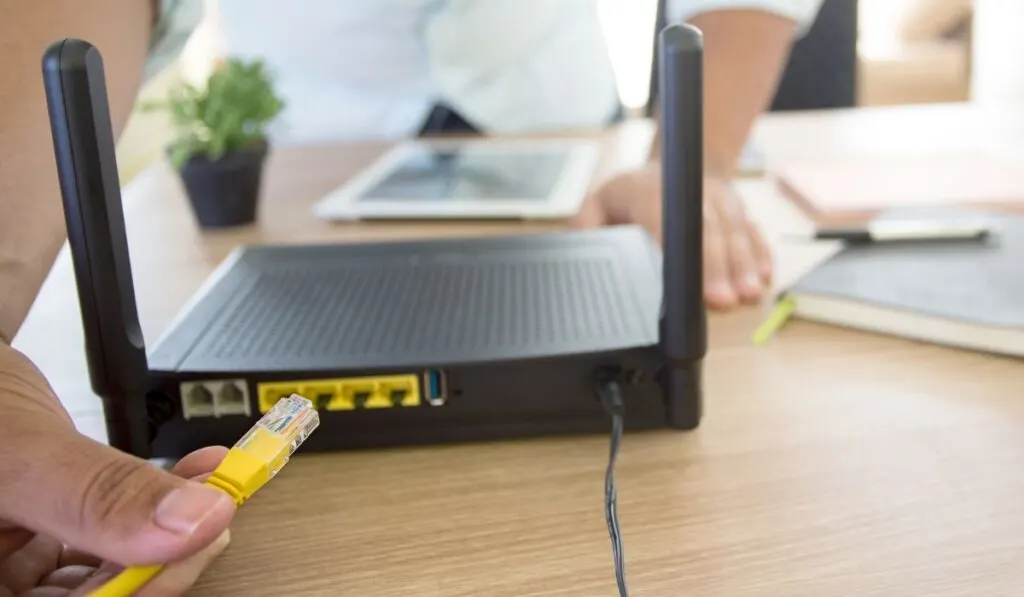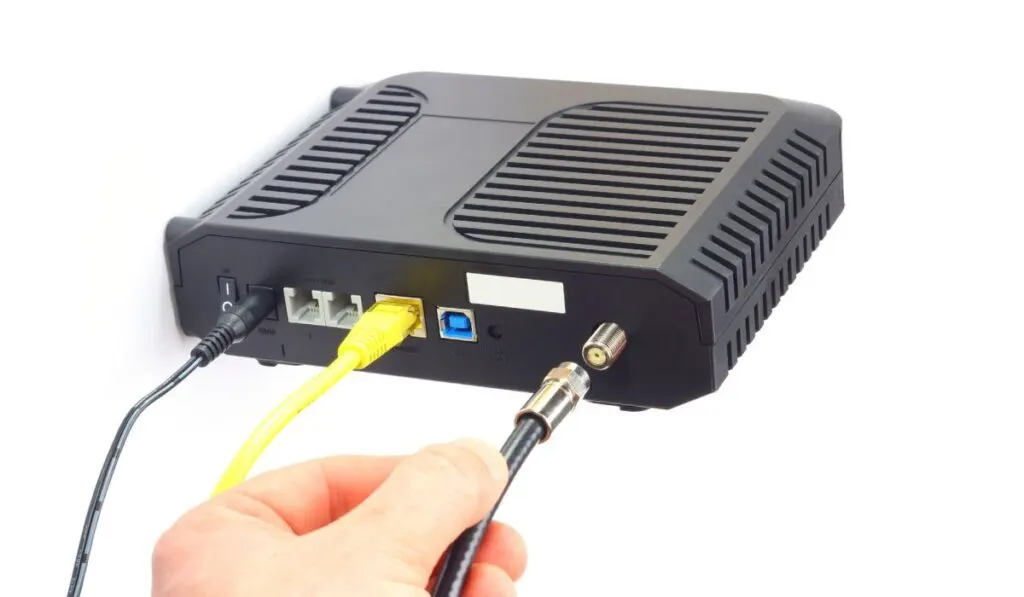Coax cables are a staple of the internet industry that have been used to grant people internet access for years, but what if you don’t have easy access to them? Is it possible to set up an internet connection without using coax cables?
Coaxial cables are necessary if you’re using cable internet service. However, it’s possible to set up internet without coax cables — and sometimes it’s the better choice. Alternatives include fiber-optic, wireless, and DSL service. Check what type of connection your building supports.
When it comes to the tech world, figuring out the different types of cables and what they’re needed for is a hurdle we all face. Let’s take a closer look at what coax cables are and how they’re used, so that you can pick the best internet option for your current setup.
What Is a Coax Cable?

A coaxial cable, or “coax” for short, is a type of electrical cable that consists of an inner conductor surrounded by a dielectric insulation layer, which is then covered by a conductive shield and an outer insulating jacket. The inner conductor is typically made of copper, while the outer shield is usually made of braided wire or aluminum foil.
Coax cables are commonly used for a wide range of applications, including television and cable television, radio antennas, and computer networks. They’re also used in industrial, scientific, and medical equipment, as well as in aviation and military communications.
One of the key advantages of coax cables is their ability to transmit high-frequency signals over long distances with minimal loss of signal quality. This is due to the shielding provided by the outer conductor, which helps to protect the inner conductor from electromagnetic interference (EMI) and radio frequency interference (RFI).
Coax cables are also relatively easy to install and terminate, making them a popular choice for both professional and DIY applications. They can be terminated with various types of connectors, such as F-connectors, BNC connectors, and TNC connectors, depending on the specific application.
There are several different types of coax cables, each with their unique characteristics and applications. For example, RG-6 and RG-59 are commonly used for cable television and satellite TV, while RG-8 and RG-213 are typically used for Amateur Radio and other high-frequency applications. LMR-400 is used for wireless communication over long distances, such as WiFi and cellular networks.
Do I Need a Coax Cable to Connect to the Internet?
A coax cable is typically used to connect to the internet via a cable modem, which is a type of modem that uses the cable television infrastructure to provide internet access. If you have a cable internet service, then you’ll likely need a coax cable to connect your cable modem to the wall outlet in your home. However, there are other ways to connect to the internet that don’t require a coax cable.
One alternative to cable internet is DSL (digital subscriber line) service, which uses the existing telephone lines to provide internet access. In this case, you would need a phone line to connect to the internet — but not a coax cable.
You could also have fiber-optic internet, which uses fiber-optic cables to provide internet access. This type of internet service is not as widely available as cable or DSL, but it can offer faster speeds and more reliable connections.
Another alternative is wireless internet, which uses radio waves to connect to the internet. There are several different types of wireless internet, including WiFi and mobile internet (such as 4G or 5G). With wireless internet, you don’t need a coax cable or any other type of physical cable to connect to the internet.
Is a Coax Cable Better Than an Ethernet Cable?

Coaxial and Ethernet are two types of wired networking cables that are used to transmit data, but they have some key differences.
Coaxial cable is typically used to connect cable modems to a television or to connect a television to a cable box. Coax is also used for cable television service, and it’s typically thicker and more durable than Ethernet cable.
Coaxial cable is less susceptible to interference than other types of cables, making it suitable for use in environments with a lot of electromagnetic interference, such as near power lines or industrial equipment. It’s also able to carry higher frequency signals, which allows for faster data transfer rates.
Ethernet cable, on the other hand, is most commonly used to connect computers and other devices to a router or switch in a local area network (LAN). Ethernet cable is typically thinner and more flexible than coaxial cable, making it easier to run through walls and ceilings. It’s also less expensive than coaxial cable.
So, a coax cable is not definitively better than an Ethernet cable. Both have their advantages and disadvantages, and the one you’ll use depends on the specific application and environment in which they’re being used. However, for a typical home environment, Ethernet is usually the better option.
How to Convert a Coax Cable to Ethernet
Since coax and Ethernet cables have similar underlying technology, they can work together quite efficiently. You’ll need to purchase an adapter, but they’re easy to source. Adapters like the Actiontec MoCA Adapter (on Amazon) are easy to use and come with a coax splitter.
The splitter is a great feature to look out for if you’re still using your coax connection for cable. Without this built-in, you’ll need to source a separate splitter, like this one (on Amazon), to get both Ethernet and cable.
Before we proceed to the setup for an adapter, make sure your home can take cable internet. This is the only type of internet that can work with the existing coax system in your home.
To get the job done, you’ll need a coaxial cable with connectors, an Ethernet cable with connectors, a MoCA coax-to-Ethernet adapter, as well as a router to get this done properly. (Note: You will need both an adapter for your router and one for each coax end you intend to connect to.)
That means that you’ll need an additional adapter for each consecutive area you want to connect to using this method. Some routers/WiFi extenders have a MoCA adapter built in. Sourcing one of these will allow you to omit the adapter on the router side.
Let’s get into the extract steps you will need to do to convert a cable from coax to Ethernet:
- Make sure your router is turned on and connected.
- Connect an Ethernet cable to your router.
- The other RJ45 connector should go into the ethernet in port on your MoCA adapter.
- Now, connect a coaxial cable from the adapter to the coax connection outlet on the wall.
- Next, find the area in your home where you want to access your new connection.
- Find the coax wall plate.
- Plug one end of a coax cable into the wall plate and the other end into the other adapter.
- Next, run an Ethernet cable from the adapter to your device or devices.
- You should now have access to your network.
What Are the Advantages of Using a Coax to Ethernet Connection?

Using MoCA to transfer the internet through your coax system has some important benefits. While WiFi does offer its conveniences, it’s not without faults. But, with MoCA, you can alleviate a lot of the common WiFi annoyances.
Some of the most common problems with WiFi are connections that are less than reliable, dead spots in the home, as well as varying upload/download speeds. Using coax to Ethernet can solve many of these problems with a hardwire connection.
If you’re using internet-intensive streaming services or gaming, you know how important reliable access to your network is. MoCA can provide this connection with no degradation to the quality. This is because the capacity for coaxial cables to transfer data is so high, around 1,000mbps.
To put that in perspective, the average home network only needs around 25mbps.
In most cases, MoCA beats out regular mesh WiFi every time. Even WiFi networks with good speed can still have low quality; moreover, some people try to use Ethernet and WiFi at the same time, but this won’t lead to a faster connection.
Fast WiFi networks can be slow sometimes due to high lag times and latency issues. Using a WiFi repeater may help strengthen your connection, but it will strain your bandwidth. That’s another reason why using MoCA is great; it can be a way to connect devices without affecting your WiFi’s bandwidth.
To sum up, using coax to ethernet connection via MoCA can do a couple of things, including providing more reliable access to your network via a hardwired connection, improving your system by almost 300%, and limiting the reliance on your WiFi bandwidth, freeing it up for other devices.
Another distinct advantage of this type of system is that it’s already in your home. All the necessary wire systems are already in place. All you need to do is source adapters. Furthermore, it can be a better connection than you’ll get using just WiFi.
